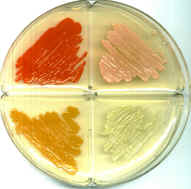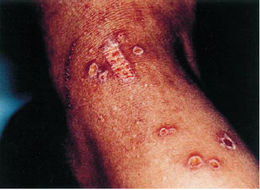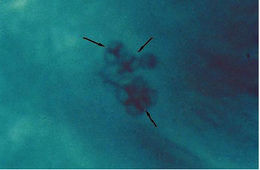Micrococcus: Difference between revisions
No edit summary |
No edit summary |
||
| Line 24: | Line 24: | ||
''M. luteus'' can be found in many places such as the human skin, water, dust, and soil. Micrococcus was first isolated by Alexander Fleming in 1929, as Micrococcus lysodeikticus before it was known as micrococcus luetus (Ganz et al, 2002) | ''M. luteus'' can be found in many places such as the human skin, water, dust, and soil. Micrococcus was first isolated by Alexander Fleming in 1929, as Micrococcus lysodeikticus before it was known as micrococcus luetus (Ganz et al, 2002) | ||
''Micrococcus'' is generally thought of as harmless bacterium, but there have been rare cases of ''Micrococcus'' infections in people with compromised immune systems, as occurs with HIV patients. M. lutues can be mistaken for S. aureus. The two species share similar colony morphology as well as a similar yellow colony color. To distinguish between the two, a bacitracin test may be performed. M. lutues does not grow in the presence of bacitracin, and will leave a clear ring with no growth on the dish around the bacitracin disk. | ''Micrococcus'' is generally thought of as harmless bacterium, but there have been rare cases of ''Micrococcus'' infections in people with compromised immune systems, as occurs with HIV patients. M. lutues can be mistaken for S. aureus. The two species share similar colony morphology as well as a similar yellow colony color. To distinguish between the two, a bacitracin test may be performed. M. lutues does not grow in the presence of bacitracin, and will leave a clear ring with no growth on the dish around the bacitracin disk. M. luteus is unique in its ability to absorb UV radiation. It has pigments that absorb long wave UV radiation, between 350-475 nanometers. Due to M. luteus’ ability to absorb these wavelengths, cosmetic companies are researching it as a possible advancement in UV skin protection. | ||
==Genome Structure== | ==Genome Structure== | ||
Hybridization studies show no close genetic relationship among the species of ''Micrococcus. ''For example, ''M. luteus'' and ''M. lylae'' are 40-50% genetically different. ''M. luteus'' has a G-C content of 65-75 mol%. ''M. varians'' has a G-C content of 66-72mol% (Fox, 1976). About half of the strains of ''M. luteus'' were found to carry plasmids 1 to 100MDa in size. So far two genome sequences have been done, one on [http://www.ncbi.nlm.nih.gov/genomes/framik.cgi?db=genome&gi=17229 Micrococcus sp. 28 plasmid pSD10] and another on [http://www.ncbi.nlm.nih.gov/genomes/framik.cgi?db=genome&gi=16053 Micrococcus luteus plasmid pMLU1.]The M. luteus genome encodes only four sigma factors and 14 response regulators, a finding indicative of adaptation to a rather strict ecological niche;mammalian skin (Young et al, 2009)M. luteus is also highly sensitive to beta-lactam antibiotics. | M. luteus has one of the smallest genomes of all bacteria. Hybridization studies show no close genetic relationship among the species of ''Micrococcus. ''For example, ''M. luteus'' and ''M. lylae'' are 40-50% genetically different. ''M. luteus'' has a G-C content of 65-75 mol%. ''M. varians'' has a G-C content of 66-72mol% (Fox, 1976). About half of the strains of ''M. luteus'' were found to carry plasmids 1 to 100MDa in size. So far two genome sequences have been done, one on [http://www.ncbi.nlm.nih.gov/genomes/framik.cgi?db=genome&gi=17229 Micrococcus sp. 28 plasmid pSD10] and another on [http://www.ncbi.nlm.nih.gov/genomes/framik.cgi?db=genome&gi=16053 Micrococcus luteus plasmid pMLU1.]The M. luteus genome encodes only four sigma factors and 14 response regulators, a finding indicative of adaptation to a rather strict ecological niche;mammalian skin (Young et al, 2009)M. luteus is also highly sensitive to beta-lactam antibiotics. | ||
This may be due to the presence of a reduced number of penicillin-binding proteins and the absence of a wblC gene, which plays an important role in the antibiotic resistance in other actinobacteria (Young, 2009) | This may be due to the presence of a reduced number of penicillin-binding proteins and the absence of a wblC gene, which plays an important role in the antibiotic resistance in other actinobacteria (Young, 2009) | ||
| Line 78: | Line 78: | ||
Greenblatt, C.L., Baum, J., Klein, B.Y., Nachshon, S., Koltunov, V., Cano, R.J., (2004). "Micrococcus luteus – Survival in Amber". Microbial Ecology 48 (1): 120–127. | Greenblatt, C.L., Baum, J., Klein, B.Y., Nachshon, S., Koltunov, V., Cano, R.J., (2004). "Micrococcus luteus – Survival in Amber". Microbial Ecology 48 (1): 120–127. | ||
SINTEF. "Super sunscreen from fjord bacteria." ScienceDaily. ScienceDaily, 6 August 2013. <www.sciencedaily.com/releases/2013/08/130806091556.htm>. | |||
Revision as of 01:35, 13 May 2016
A Microbial Biorealm page on the genus Micrococcus

Classification
Higher order taxa:
Bacteria; Actinobacteria; Actinobacteria (class); Actinobacteridae; Actinomycetales; Micrococcineae; Micrococcaceae
Species:
Micrococcus antarcticus; M. luteus; M. lylae; M. roseus; M. agilis; M. kristinae; M.sedentarius; M. halobius; M. sp.
|
NCBI: Taxonomy Genome: -Micrococcus sp. 28 plasmid pSD10 -Micrococcus luteus plasmid pMLU1. |
Kocur, M., Klosss, W. E., & Schliefer, K. (2006). The Genus Micrococcus. Prokaryotes, 3, 961-971. doi:10.1007/springerreference_3714
Description and Significance
M. luteus can be found in many places such as the human skin, water, dust, and soil. Micrococcus was first isolated by Alexander Fleming in 1929, as Micrococcus lysodeikticus before it was known as micrococcus luetus (Ganz et al, 2002) Micrococcus is generally thought of as harmless bacterium, but there have been rare cases of Micrococcus infections in people with compromised immune systems, as occurs with HIV patients. M. lutues can be mistaken for S. aureus. The two species share similar colony morphology as well as a similar yellow colony color. To distinguish between the two, a bacitracin test may be performed. M. lutues does not grow in the presence of bacitracin, and will leave a clear ring with no growth on the dish around the bacitracin disk. M. luteus is unique in its ability to absorb UV radiation. It has pigments that absorb long wave UV radiation, between 350-475 nanometers. Due to M. luteus’ ability to absorb these wavelengths, cosmetic companies are researching it as a possible advancement in UV skin protection.
Genome Structure
M. luteus has one of the smallest genomes of all bacteria. Hybridization studies show no close genetic relationship among the species of Micrococcus. For example, M. luteus and M. lylae are 40-50% genetically different. M. luteus has a G-C content of 65-75 mol%. M. varians has a G-C content of 66-72mol% (Fox, 1976). About half of the strains of M. luteus were found to carry plasmids 1 to 100MDa in size. So far two genome sequences have been done, one on Micrococcus sp. 28 plasmid pSD10 and another on Micrococcus luteus plasmid pMLU1.The M. luteus genome encodes only four sigma factors and 14 response regulators, a finding indicative of adaptation to a rather strict ecological niche;mammalian skin (Young et al, 2009)M. luteus is also highly sensitive to beta-lactam antibiotics. This may be due to the presence of a reduced number of penicillin-binding proteins and the absence of a wblC gene, which plays an important role in the antibiotic resistance in other actinobacteria (Young, 2009)
Cell Structure and Metabolism


Micrococcus are Gram-positive cocci that are 0.5 to 3.5 micrometers in diameter and usually arranged in tetrads or irregular clusters. They are generally strict aerobes and can generally reduce nitrate. M. luteus oxidizes carbohydrates to CO2 and water, and it does not produce acid from glucose as well as it does not make arginine dihydrolase or b-galactosidase. Some Micrococcus are pigmented bacteria; for example, M. luteus produces yellow colonies and M. roseus produces redish colonies. Micrococcus species are oxidase-positive, which can be used to distinguish them from other bacteria like most Staphylococcus species, which are generally oxidase-negative.Micrococcus species can also be differentiated from staphylococcus species by the Taxo A Bacitracin disk test. Micrococcus species are sensitive to Bacitracin while staphylococci are resistant. Defining characteristics of Micrococcus are the ability to aerobically produce acid from glucose glycerol, aesculin hydrolysis, arginine dihydrolase, major pigment production, motility, and conversion of nitrate to nitrite (Smith et al. 1999).Micrococcus luteus can synthesize iso- and anteiso-branched alkenes by the head-to-head condensation of fatty-acid thioesters [coenzyme A (CoA) or acyl carrier protein (ACP)].This ability could be harnessed to make biofuels (Pereira et al, 2012)
Ecology
M. luteus has been isolated from human skin, animal and dairy products, and beer. It can be found in many other places in the environment, as well, like water, dust, and soil. M. luteus on human skin breaks down compounds in sweat into compounds with bad odor. M. luteus can grow well in environments with little water or high salt concentrations. M. varians is the second most frequently isolated species of micrococcus after Micrococcus luteus (Kloos & Musselwhite, 1975). They grow optimally at 37oC and can be easily grown on inorganic nitrogen agar or Simmon's citrate agar. Although some, like Micrococcus antarcticus, are cold-adapted, and have been found living in Antarctica and in marine environments.
Pathology


Although Micrococcus rarely causes infections or problems in the body, those with compromised immune systems, such as occurs with HIV+ patients, have been known to get skin infections caused by Micrococcus luteus. The skin infections, or chronic cutaneous infections, result in pruritic eruptions of the skin in some areas as well as scattered papule lesions with or without central ulcerations. Micrococcus as the cause of infections is easy to overlook because infections caused by this bacterium are rare as well as the bacterium is a natural part of the skin's bacterial flora. Thus, when dealing with Micrococcus infections, it usually takes several cultures being grown and examined (at about 35oC on blood agar) before one realizes that Micrococcus is indeed the culprit. Most Micrococcus infections are discovered through process of elimination (all other bacterial, fungal, etc. tests showing up negative) along with the presence of abundant Micrococcus tetrads in the lesions or cysts (which would normally have been overlooked because Micrococcus is a natural part of the skin's microbial flora) (Smith, et al. 1999). Though today immunocompromised patients the risk of infection has grown. There have been several deaths in immunocompromised children (caused by leukemia) from pulmonary hemorrhages because of Micrococcus. Recently, this organism was recognized as an opportunistic pathogen and has been implicated in recurrent bacteremia, septic shock, septic arthritis, endocarditis, meningitis, intracranial suppuration, and cavitating pneumonia in immunosuppressed patients.
References
Encyclopedia Britannica: Micrococcus
Health Canada: Material Safety Data Sheet: Micrococcus spp.
MadSci Network: What are the effects of Micrococcus luteus on the human body?
Sciencenet: Micrococcus luteus
Ganz, T., Gabayan, V., Liao,, H., Liu, L., Oren, A., Graf, T., & Cole, A. (2002). Increased inflammation in lysozyme M-deficient mice in response to Micrococcus luteus and its peptidoglycan. Blood, 101(6), 2388-2392. doi:10.1182/blood-2002-07-2319
Young, M., Artsatbanov, V., Beller, H. R., Chandra, G., Chater, K. F., Dover, L. G., . . . Greenblatt, C. L. (2009). Genome Sequence of the Fleming Strain of Micrococcus luteus, a Simple Free-Living Actinobacterium. Journal of Bacteriology, 192(3), 841-860. doi:10.1128/jb.01254-09
Pereira, J. H., Goh, E., Keasling, J. D., Beller, H. R., & Adams, P. D. (2012). Structure of FabH and factors affecting the distribution of branched fatty acids in Micrococcus luteus. Acta Crystallographica Section D Biological Crystallography, 68(10), 1320-1328. doi:10.1107/s0907444912028351
Falk, D., and Guering S,J.,(1983) Differentiation of Staphylococcus and Micrococcus spp. with the Taxo A bacitracin disk.Journal of Clinical Microbiology,18(3) 719-721
Greenblatt, C.L., Baum, J., Klein, B.Y., Nachshon, S., Koltunov, V., Cano, R.J., (2004). "Micrococcus luteus – Survival in Amber". Microbial Ecology 48 (1): 120–127.
SINTEF. "Super sunscreen from fjord bacteria." ScienceDaily. ScienceDaily, 6 August 2013. <www.sciencedaily.com/releases/2013/08/130806091556.htm>.
